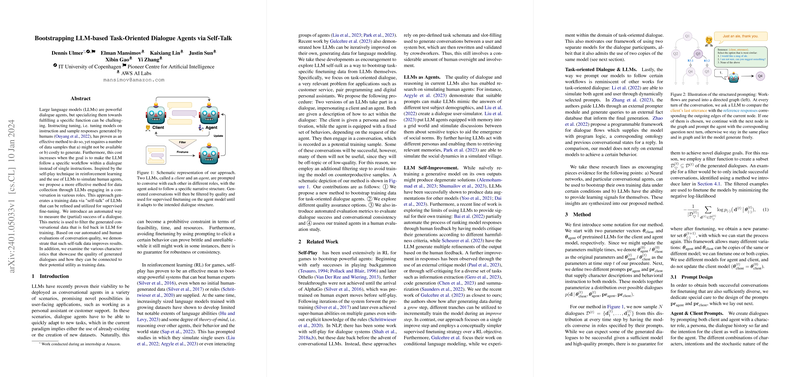Introduction to Bootstrapped Dialogue Agents
LLMs have emerged as potent tools capable of powering conversational agents across a spectrum of applications, from virtual assistants to customer support. These models are adept at understanding and responding to a variety of user inputs. However, tailoring LLMs to handle specific tasks or to navigate through prescribed workflows within conversations requires additional training data, which can be scarce or expensive to produce.
Novel Approach to Data Generation
An innovative approach to overcome this hurdle involves LLM's self-conversation capabilities to generate their own training data—a method delineated as "self-talk." This technique enables two variations of LLMs to partake in scripted dialogs, acting as both the client and the agent. The agent is assigned a structured set of behavioral processes while the client embodies a character with a unique persona. Their ensuing interaction generates novel conversational data which, after being selectively sifted for quality, can be fed back to refine the agent’s abilities to adhere to specific dialog workflows.
A clear advantage of this method is the automation of data collection without direct human involvement. Yet, this raises a crucial question: Can LLMs effectively refine their skills solely based on internally generated conversations?
Self-Talk Advantages and Implementation
The use of self-talk in training dialogue agents has demonstrated promising advantages. It relies less on costly human-generated data and enables the LLM to simulate both sides of an interaction—thus rapidly producing a diverse dataset. The paper explains that by absorbing successful conversation patterns from these self-dialogs, an LLM can improve its capacity to stick to a task-focused conversation flow.
The success of a dialogue is computed using a new automated metric that filters out only the high-quality exchanges. These dialogues are then utilized to finetune the task-oriented agent model. The paper carries significant weight as it also proffers new automated evaluation metrics to assess conversation success and consistency.
Validation and Human-Centric Considerations
Through both human evaluations and automated metrics, the paper validates that models fine-tuned with self-talk data show tangible improvements in managing task-oriented dialogues. While the model predominantly benefits from operating on such filtered, self-generated datasets, potential failures such as conversational loops or non-adherence to workflows suggest arenas for enhancement.
The research opens avenues for more robust and less labor-intensive methodologies for improving dialogue agents, inviting exploration into multi-turn dialogue settings, the impact of model sizes, and the extent to which LLMs can furnish self-improvement signals. However, this paper’s focus is specific to task-oriented figures and doesn’t digress into open-ended dialogues or other NLP task variations.
In summarizing this research, it's fundamental to acknowledge that while the concept of virtual agents training through self-conversation is a leap forward, the potential amplification of biases and the unintended consequences of further reducing the human oversight in model training require careful ethical consideration. The findings from this work ultimately bolster the idea that LLMs hold the potential to self-evolve and to become more effective conversational partners.
